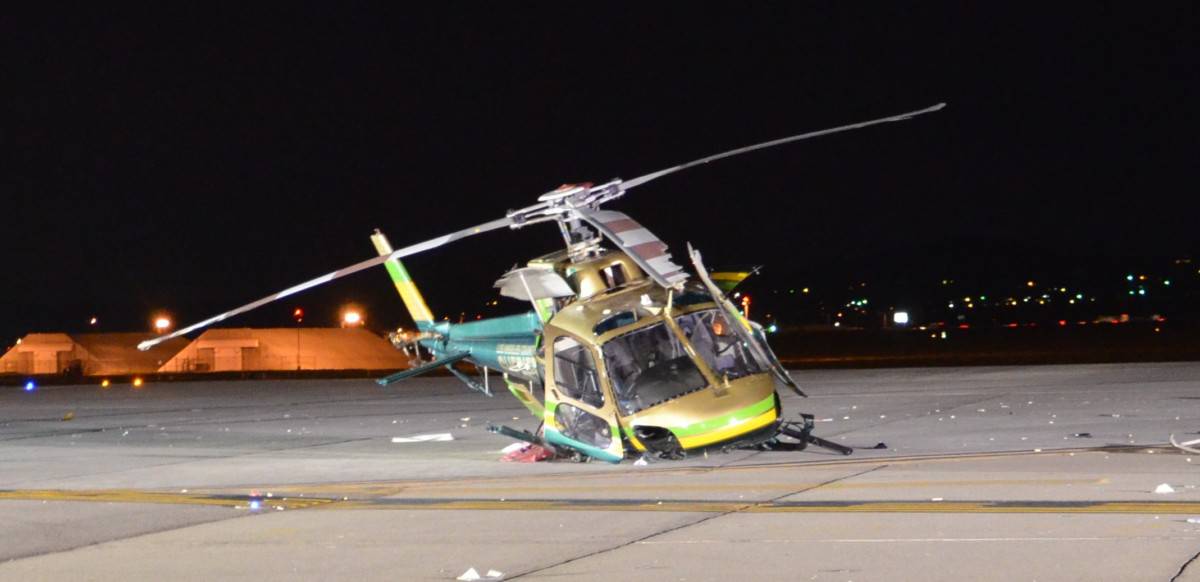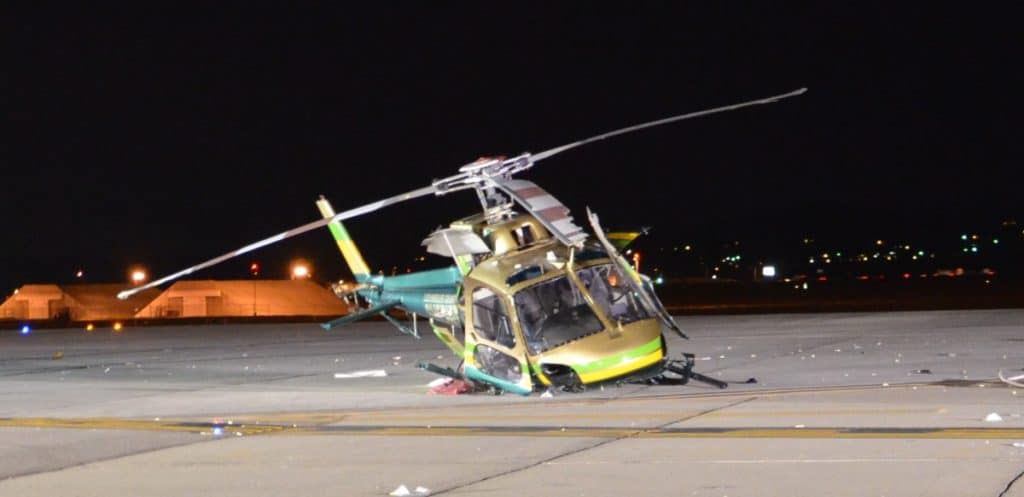
Helicopters have been filmed many times spinning out of control, usually just before they crash. Why do they spin out of control and why don’t the pilots stop it and prevent the crash? There have been a few famous videos of where fatal accidents have followed a helicopter spinning out of control, the most recent was the Leonardo AW169 taking off from Leicester City Soccer Stadium in the UK.
A helicopter may spin out of control when the anti-torque system is unable to counteract the torque being created by the engine. When the torque of the engine is greater than the thrust being produced by the anti-torque system, the helicopter will begin to spin.
Having had the opportunity to practice many different crash prevention techniques in a full-motion simulator I am able to tell you a little bit about why this happens and what the pilots can and can not do about it.
A helicopter going into a spin is one of the most terrifying emergencies a pilot may have to deal with. Depending on where it happens, can mean the difference between a survivable landing or not.
What Makes A Helicopter Spin?
When a helicopter is working correctly the engine drives the main rotor via a transmission. Because of Newton’s Third Law ‘For Every Action, There is an Equal and Opposite Reaction’ this makes the fuselage want to rotate in the opposite direction to the main rotor. This is known as ‘Torque’. Think of it like drilling a hole and the drill bit sticks, the drill wants to rotate around and hit you.
When the helicopter is sitting on the ground, the friction of the wheels or skid on the ground prevents the fuselage from spinning in the opposite direction to the main rotor. But when a helicopter lifts into a hover, this friction disappears and without some form of anti-torque system, the helicopter would spin.
On a typical helicopter, the anti-torque system is the tail rotor.
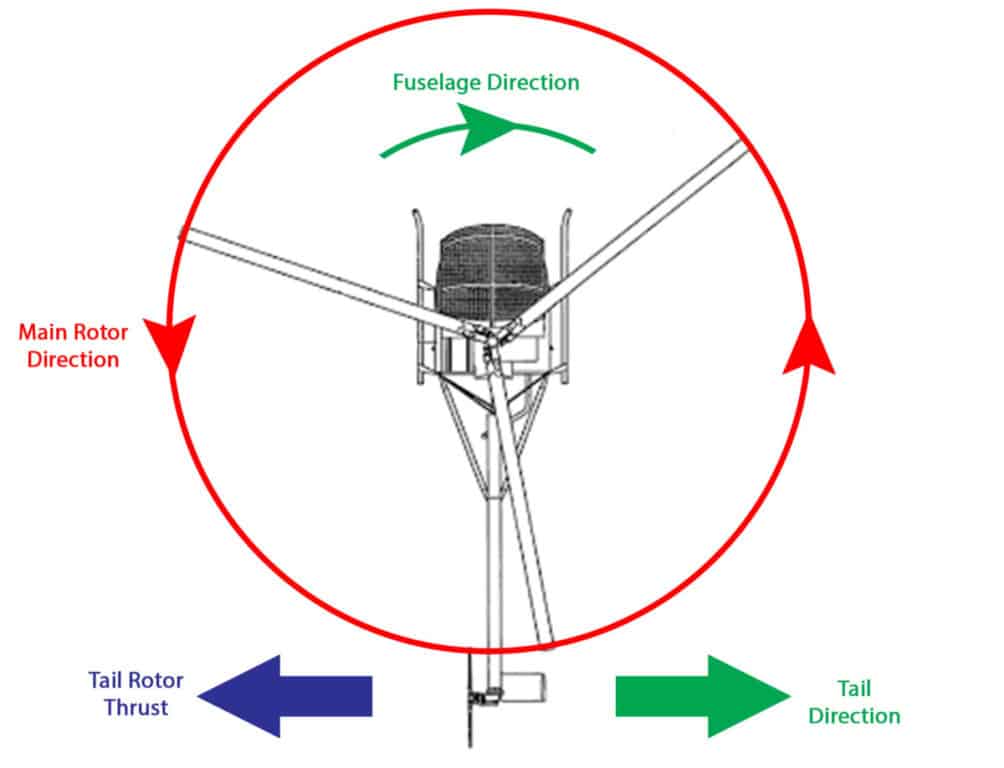
A tail rotor counteracts the torque on the fuselage by producing thrust which pushes the tail of the helicopter in the opposite direction to the way the fuselage wants to spin. When the torque on the fuselage and the tail rotor thrust is equal then the helicopter will not spin.
When the torque is greater than the tail rotor thrust, this is when a helicopter can begin to spin.
The pilot uses the foot pedals in the helicopter to alter the pitch of the tail rotor blades to slightly increase or decrease the thrust produced by the tail rotor system. This allows for fine-tuning of the thrust vs. torque and to turn the helicopter when in a hover.
There are other types of anti-torque systems on a helicopter, but for simplicity, in this article, we will focus on the conventional tail rotor. If you would like to know more about the tail rotor or the different types of anti-torque systems on the world’s helicopters be sure to check out my ‘Further Reading’ section at the end of this article.
There are two ways that this balance of thrust and torque can be imparted on a helicopter:
- Loss of Tail Rotor Trust
- Loss of Tail Rotor Effectiveness
What is Loss of Tail Rotor Thrust on a Helicopter?
On a conventional helicopter, the tail rotor airfoils produce horizontal thrust as they spin, just like a fan sitting next to you on a hot day. The tail rotor is driven off the main transmission so when the main rotor turns, so does the tail rotor.
On the Astar that I fly, the tail rotor turns approximately 7 revolutions for every single revolution of the main rotor. The amount of thrust the tail rotor produces is balanced to match the engine torque but when the tail rotor ceases to produce thrust, this is where the spinning begins.
There are usually two ways that prevent the thrust being produced:
Tail Rotor Drive Failure
The tail rotor is connected to the main transmission by a drive tube or series of drive tubes. These drive tubes run along the length of the tailboom to a gearbox which then turns the drive 90° and connects with the horizontally mounted tail rotor at the back of the helicopter.
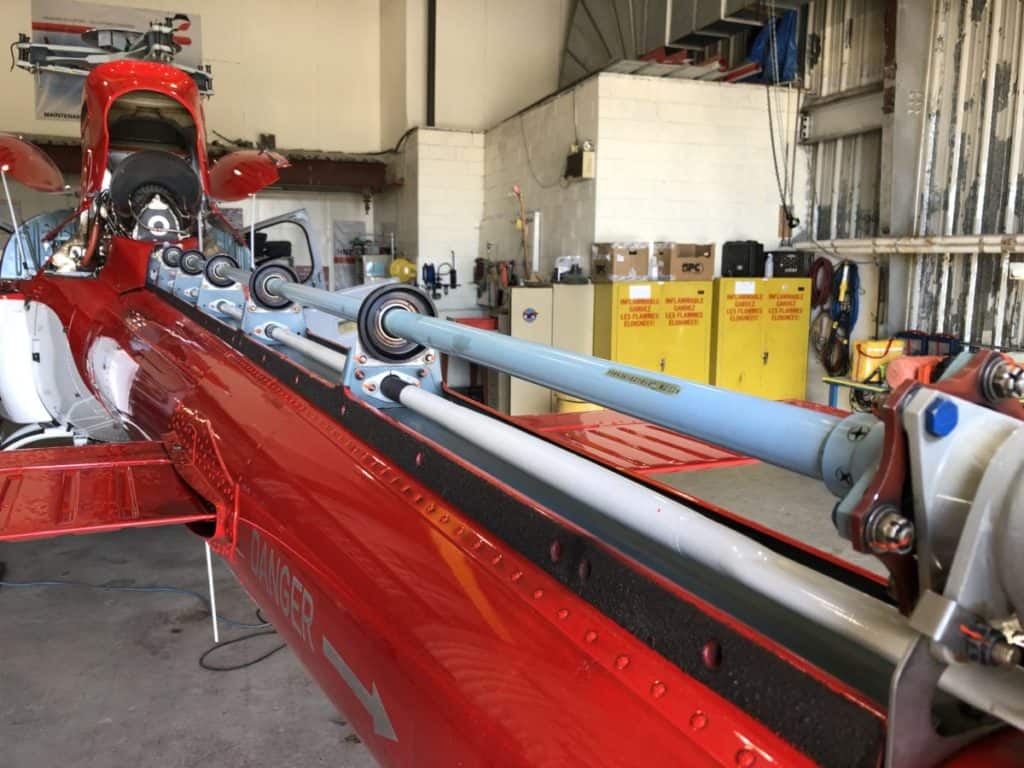
If any part of the tail rotor drive system fails and stops delivering power to the tail rotor, the tail rotor will begin to slow down. The thrust produced by the tail rotor depends on the rpm of it staying constant. If the tail rotor slows down due to its drive system becoming disconnected, the torque of the main fuselage will be greater than the thrust being produced by the tail rotor.
This will then begin to spin the helicopter as the torque and anti-torque are no longer balanced.
If the helicopter is in forward flight the large vertical fin at the back of the helicopter acts like a rudder and can help to keep the helicopter pointing straight and hopefully allow the pilot to complete a run-on landing like an airplane, providing there is a flat, clear area to do so.
If the helicopter is in a hover, or at low speed when the tail rotor loses thrust the only way to remove the spinning moment is to remove the torque creating it. By shutting off the engine the pilot will be able to enter an autorotation and the spin should stop as the engine creating the torque on the fuselage is stopped. Providing the helicopter is high enough and there is a clear enough area to land, this may end up in a successful engine-off landing.
In both situations, if there is no clear area to land or the helicopter is too low a crash is usually inevitable.

Join My Newsletter & Get Great Tips, Information and Experiences To Help You Become a Superb Pilot!
Tail Rotor Collision or Failure
A collision with the tail rotor can damage it and cause it to not produce as much thrust or non at all. When I’m out flying into unprepared areas, confined areas, or any spot that is not open and clear my main concern is making sure my main rotors and tail rotor don’t come into contact with ANYTHING!
Even contacting a small tree could have drastic consequences.
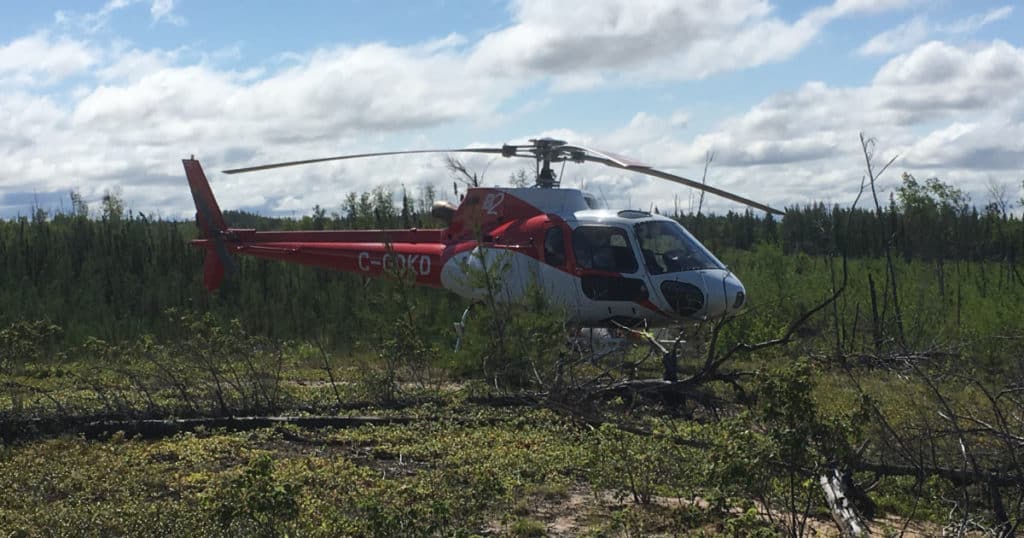
In this video below, the pilot gets their water bucket caught in the tail rotor after ignoring the bucket manufacturer’s directions and connecting it to a short line under the helicopter. This short line allowed the bucket to reach back far enough and entangle itself in the tail rotor. This stopped the tail rotor from working and the helicopter was only kept pointing straight by the forward airflow over the vertical fin.
The pilot should have used the road to complete a run-on landing at speed but instead, they slow down too much and the fin loses its aerodynamic capability and the helicopter begins to spin. The pilot was lucky that they were able to keep the helicopter level and get in on the ground before the spin became too fast. A very lucky pilot!
Click Here to See Video!
When a component in the tail rotor system fails this can also cause the tail rotor to stop producing the required amount of thrust. This is what happened to the helicopter that crashed at the Leicester City soccer stadium in October 2018.
A component failure of the control system prevented the control inputs from the pilot making it to the tail rotor blades. This loss of thrust control of the tail rotor meant the pilot was unable to balance the thrust vs. torque and a spin began.
Being unable to control the trust of the tail rotor led to the helicopter becoming uncontrollable and the ensuing impact with the ground, unfortunately, claiming the lives of all those on board.
What is Loss of Tail Rotor Effectiveness on a Helicopter?
The loss of tail rotor effectiveness, shortened to LTE is an aerodynamic situation where the tail rotor is momentarily unable to produce enough thrust to equal the torque of the fuselage and the helicopter begins to spin. For an airfoil to work efficiently, it needs clean, undisturbed air to work on, to turn at a determined rpm, and produce enough thrust when power increases as the helicopter lifts off with a heavy load, or at high altitude.
Let’s look at each of these and see how each can cause a helicopter to spin out of control:
Undisturbed Air
When an airfoil comes into contact with turbulent, fast-moving airflow it can create parts of the tail rotor blades to aerodynamically stall and those areas stop producing thrust. If these areas not producing thrust grow large enough the balance of thrust to torque reduces and the torque will cause the helicopter to spin.
There are three main areas where the pilot has to closely monitor which way the wind is blowing in relation to the helicopter:
Tail Rotor Interference
To create thrust the tail rotor must push air away from it to force the tail boom in the opposite direction. This is like paddling a canoe, oar goes into the water, you pull it back, canoe goes forward.
If a strong wind is blowing into the air coming from the tail rotor, it can prevent the tail rotor from producing enough thrust. Imagine paddling up a river where the flow is too strong for you, you end up going backward.
This wind causes the thrust to be less than the fuselage torque and a spin can begin.
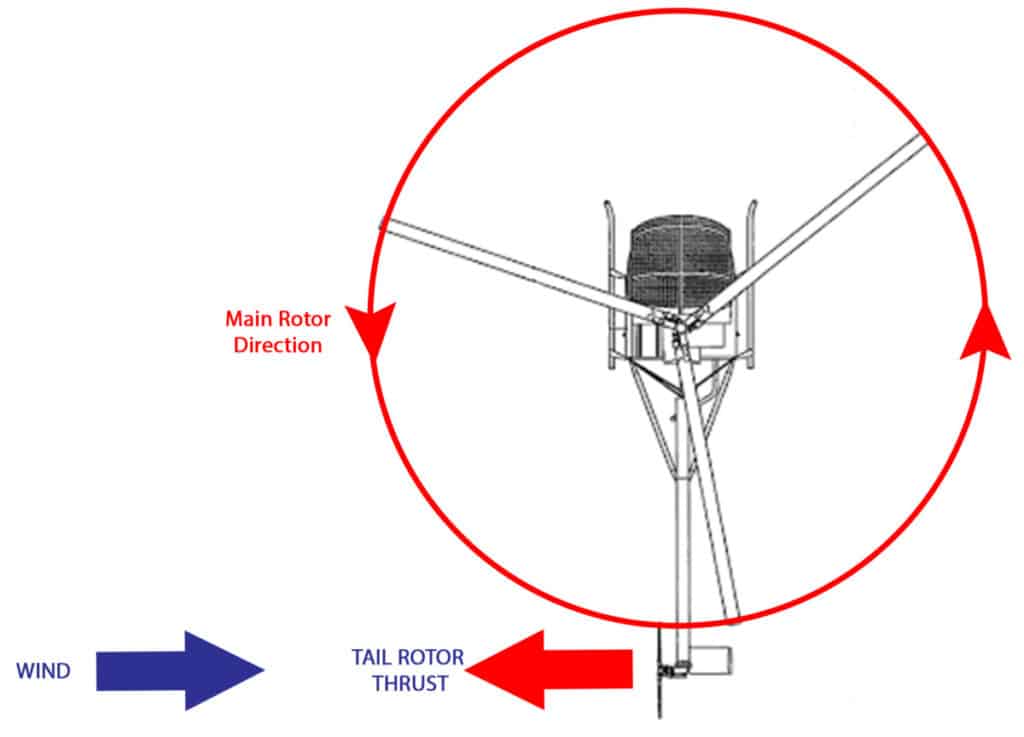
Tail Wind
When the wind is blowing from the rear of the helicopter it flows the wrong way across the vertical fin at the back of the helicopter. This fin wants to weathercock the helicopter into wind.
Careful and timely yaw control is required by the pilot to prevent the wind from starting to rotate the helicopter,

Main Rotor Interference
When the airflow leaves an airfoil it is turbulent and lumpy. If this airflow then passes into the tail rotor the airfoils on the tail rotor are not getting clean, undisturbed air to work on. This can cause them to create areas of stalled airflow mentioned earlier.
Stalled airflow = less thrust produced and then an imbalance against fuselage torque happens, creating a spin.
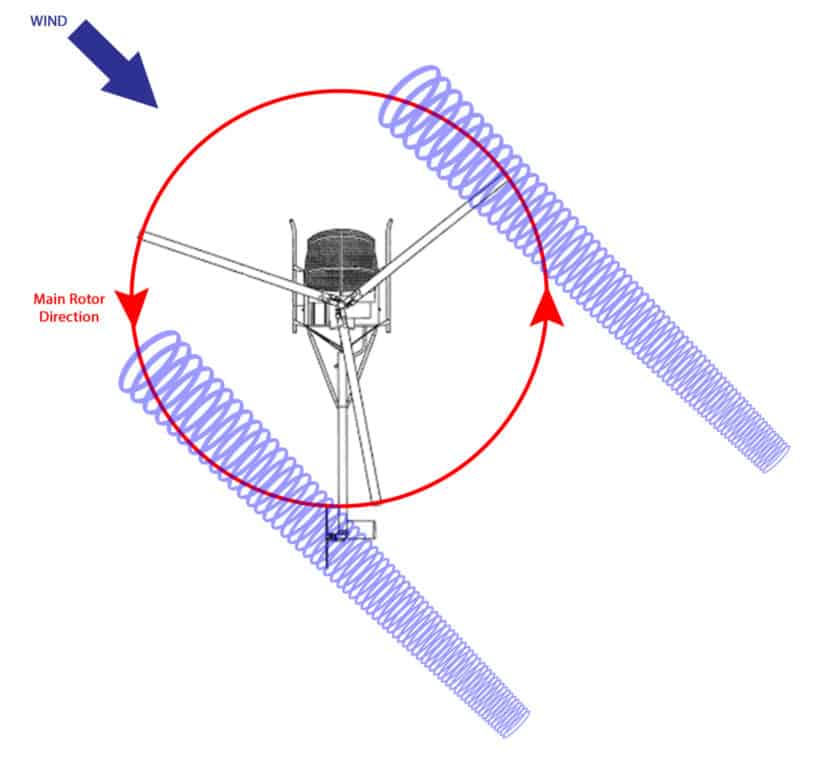
With all of these areas creating a possible spinning moment of the helicopter, they can feed into one another as the helicopter rotates around. If you follow the diagram sequence, a small rotational moment develops from a tail rotor interference which then turns the tail into the tailwind area which adds to the rotational moment, and then as the fuselage rotates further it then becomes influenced by the main rotor interference.
If the pilot is not quick enough to stop the rotational moment, the helicopter can develop into a full-on aerodynamically induced spin that can lead to an accident if the helicopter is too close to the ground to allow the pilot to recover.
Determined RPM
At the start of the article, I mentioned how the Astar that I fly has a tail rotor that turns 7x faster than the main rotor. The thrust developed by a tail rotor is dependent on its rotation speed or velocity squared, therefore any change in rpm of the tail rotor dramatically changes how much thrust it produces.
The tail rotor is mechanically driven by the main transmission so it cannot change its speed unless the main rotor changes its speed, however, this is where the problem occurs. When the helicopter is lifting heavy loads, at low speed, at high altitude, or a combination of all three the pilot can begin to reach the maximum amount of power the engine/s can produce. Once this maximum power is reached any more demand for power leads to a situation called ‘Overpitching’.
When a helicopter overpitches, the power is not enough to overcome the drag created by the main rotor blades as they turn and this causes the main rotor rpm to drop. Remember, the tail and main rotors are connected so if the main rotor rpm drops by just 1rpm, the tail rotor slows by 7rpm.
Now here is the kicker, because tail rotor thrust produced is velocity2, the tail rotor thrust is beginning to reduce at a rapid rate for every 1rpm the main rotor loses. The helicopter reaches a point where the tail rotor thrust and the fuselage torque are not balanced and a spin begins to develop.
Here is a great video of a Sky Crane getting LTE. It is slow, heavy, and operating in hot conditions because of the fire, and possibly up at altitude in the mountains:
To recover from this spin, the pilot dumps the 10,000 liter load of water, reducing the weight of the helicopter by 22,000 lb, and instantly the power required to keep the helicopter flying is almost halved. This allows the engines to restore the main rotor to its correct RPM, allowing the tail rotor to go back to its correct RPM and the thrust and torque once again become balanced.
To Finish
Helicopters spin out of control when an issue arises from the anti-torque system on the helicopter. Be it a mechanical failure, the pilot hits something or the helicopter is being operated in conditions that can lead to the onset of it losing its effectiveness. Any condition that prevents the thrust being produced by the system to equal the torque imparted onto the fuselage from the engine will result in a spin starting.
Good piloting and thinking ahead can identify when some of these hazards may become a potential threat but when a helicopter suffers a component failure like what happened at Leicester City soccer stadium, that is just pure bad luck.
Depending on where the helicopter is when this imbalance occurs dramatically alters how successful the outcome of the incident becomes. If the pilot has some space, altitude, and time then they may be able to get the helicopter down safely, if not then all bets are off.

